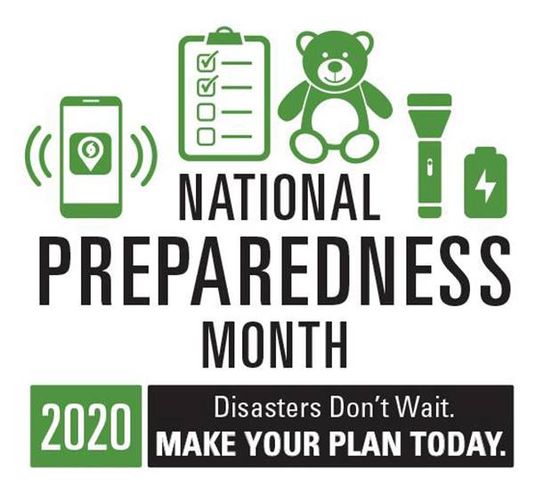SEPTEMBER IS NATIONAL PREPAREDNESS MONTH
Week 1 | Make a Plan
National Preparedness Month (NPM) is recognized each September to promote family and community disaster planning now and throughout the year. As our nation continues to respond to COVID-19, there is no better time to kick off your preparedness this September.
The 2020 National Preparedness Month theme is "Disasters Don’t Wait. Make Your Plan Today." Look for posts throughout September, focusing on different preparedness topics each week.
Week 1 | Make a Plan
Make a plan today. Talk to your friends and family about how you will communicate before, during, and after a disaster — and how to reconnect if you’re separated. Establish a family meeting place that’s familiar and easy to find.
Step 1 — Discuss the following questions with your family, friends, or household members, and then put together your emergency plan. Also check with the Centers for Disease Control (CDC) and update any emergency plans that may be affected due to Coronavirus, including the need for face coverings and disinfectants.
- - Which types of disasters could affect my area?
- How will I receive emergency alerts and warnings?
- What is my shelter plan?
- What is my evacuation route?
- What is my family/household communication plan?
- Do I need to update my emergency preparedness kit?
Step 2 — Consider the specific needs of your household. Tailor your plans and supplies to your daily living necessities and responsibilities. Create a personal network for specific areas where you need assistance and discuss how people in your network can assist each other with communication, care of children, business needs, pet care, or things like operating medical equipment. Keep some of these factors in mind when developing your plan:
- Different ages of household members, including school-aged children or elderly
- Responsibilities for assisting others
- Locations frequented
- Dietary needs
- Medical needs, including prescriptions and equipment
- Disabilities or access and functional needs, including devices and equipment
- Languages spoken
- Cultural and religious considerations
- Pets or service animals
Step 3 — Fill out a family emergency communication Plan. You can download and fill out a family emergency communication plan from Ready.gov (or use it as a guide to create your own plan) by going to: https://www.ready.gov/.../create-your-family-emergency...
Step 4 — Practice your emergency plan with your family / household.
Launched in February 2003, FEMA’s “Ready” Campaign is a National public service initiative designed to educate and empower the American people to prepare for, respond to and mitigate emergencies, including natural and man-made disasters. The goal of the campaign is to promote preparedness through public involvement.
Credit to: FEMA and Ready
